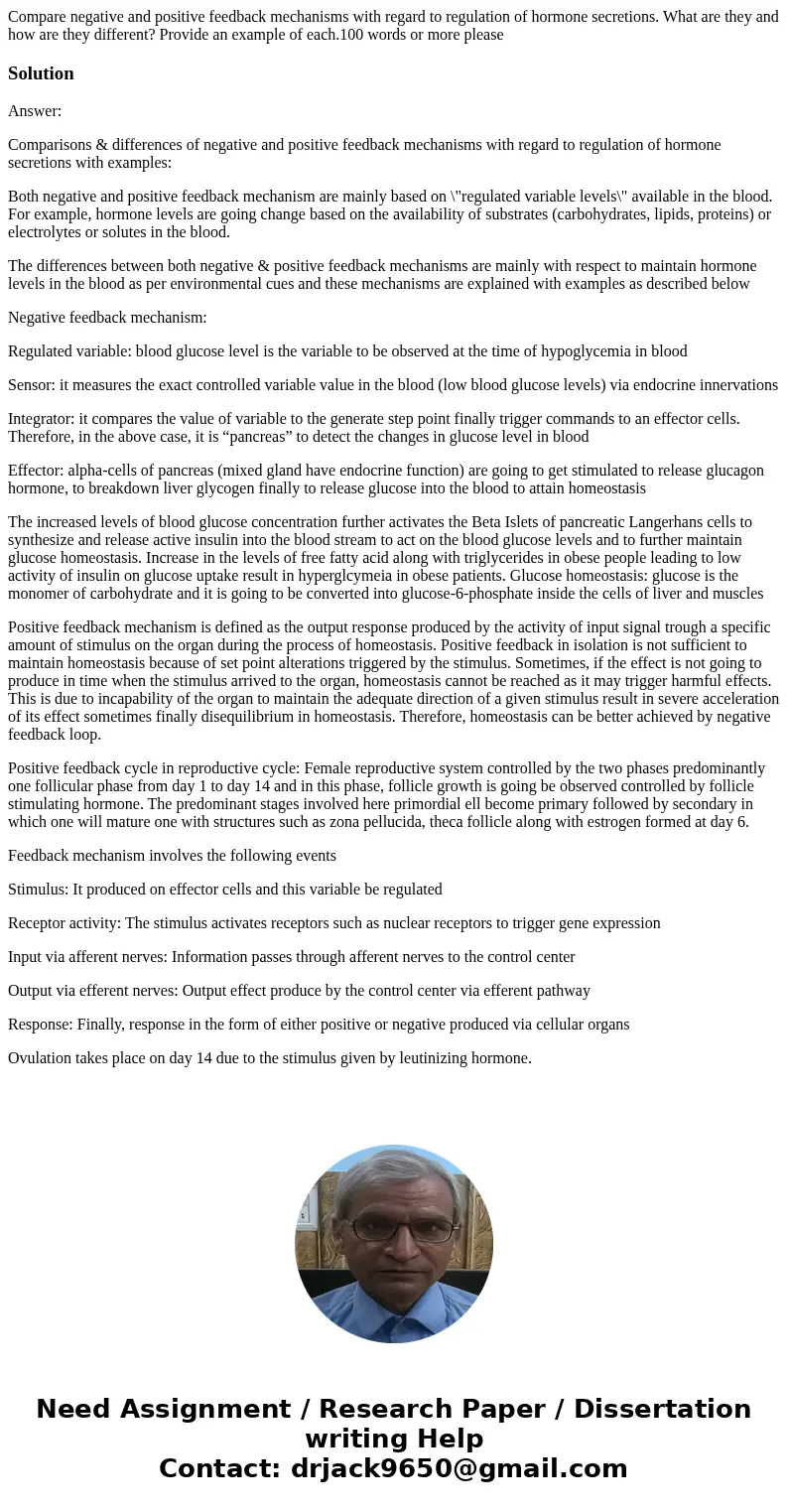Compare negative and positive feedback mechanisms with regar
Compare negative and positive feedback mechanisms with regard to regulation of hormone secretions. What are they and how are they different? Provide an example of each.100 words or more please
Solution
Answer:
Comparisons & differences of negative and positive feedback mechanisms with regard to regulation of hormone secretions with examples:
Both negative and positive feedback mechanism are mainly based on \"regulated variable levels\" available in the blood. For example, hormone levels are going change based on the availability of substrates (carbohydrates, lipids, proteins) or electrolytes or solutes in the blood.
The differences between both negative & positive feedback mechanisms are mainly with respect to maintain hormone levels in the blood as per environmental cues and these mechanisms are explained with examples as described below
Negative feedback mechanism:
Regulated variable: blood glucose level is the variable to be observed at the time of hypoglycemia in blood
Sensor: it measures the exact controlled variable value in the blood (low blood glucose levels) via endocrine innervations
Integrator: it compares the value of variable to the generate step point finally trigger commands to an effector cells. Therefore, in the above case, it is “pancreas” to detect the changes in glucose level in blood
Effector: alpha-cells of pancreas (mixed gland have endocrine function) are going to get stimulated to release glucagon hormone, to breakdown liver glycogen finally to release glucose into the blood to attain homeostasis
The increased levels of blood glucose concentration further activates the Beta Islets of pancreatic Langerhans cells to synthesize and release active insulin into the blood stream to act on the blood glucose levels and to further maintain glucose homeostasis. Increase in the levels of free fatty acid along with triglycerides in obese people leading to low activity of insulin on glucose uptake result in hyperglcymeia in obese patients. Glucose homeostasis: glucose is the monomer of carbohydrate and it is going to be converted into glucose-6-phosphate inside the cells of liver and muscles
Positive feedback mechanism is defined as the output response produced by the activity of input signal trough a specific amount of stimulus on the organ during the process of homeostasis. Positive feedback in isolation is not sufficient to maintain homeostasis because of set point alterations triggered by the stimulus. Sometimes, if the effect is not going to produce in time when the stimulus arrived to the organ, homeostasis cannot be reached as it may trigger harmful effects. This is due to incapability of the organ to maintain the adequate direction of a given stimulus result in severe acceleration of its effect sometimes finally disequilibrium in homeostasis. Therefore, homeostasis can be better achieved by negative feedback loop.
Positive feedback cycle in reproductive cycle: Female reproductive system controlled by the two phases predominantly one follicular phase from day 1 to day 14 and in this phase, follicle growth is going be observed controlled by follicle stimulating hormone. The predominant stages involved here primordial ell become primary followed by secondary in which one will mature one with structures such as zona pellucida, theca follicle along with estrogen formed at day 6.
Feedback mechanism involves the following events
Stimulus: It produced on effector cells and this variable be regulated
Receptor activity: The stimulus activates receptors such as nuclear receptors to trigger gene expression
Input via afferent nerves: Information passes through afferent nerves to the control center
Output via efferent nerves: Output effect produce by the control center via efferent pathway
Response: Finally, response in the form of either positive or negative produced via cellular organs
Ovulation takes place on day 14 due to the stimulus given by leutinizing hormone.

 Homework Sourse
Homework Sourse